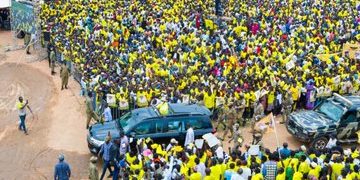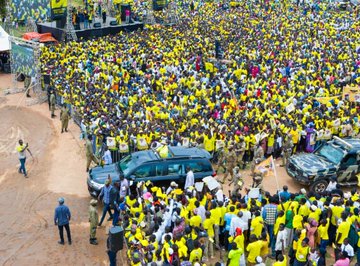OBONGI – President Yoweri Kaguta Museveni has pledged to clear what he described as the government’s “two major debts” to Obongi District — electricity and road infrastructure — assuring residents that the long-standing challenges of isolation and underdevelopment will soon be a thing of the past.
Addressing thousands of enthusiastic National Resistance Movement (NRM) supporters at Lionga Grounds in Obongi on Friday, October 17, 2025, President Museveni, who is also the NRM presidential flagbearer, said funding had already been secured to extend electricity to the district and begin tarmacking its major roads within the current financial year.
“We have two debts with Obongi, and one is electricity. Money has been secured to bring electricity to Obongi. We are going to use a World Bank loan to do this,” the President said.
“They’re now doing procurement, looking for the right company to do the work. That debt is paid because the money is already there.”
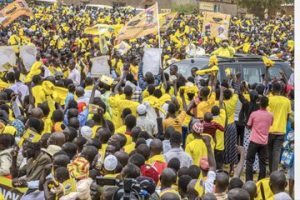
He noted that Obongi and Buvuma remain the only districts in Uganda not yet connected to the national electricity grid — a situation he said will soon change once construction of the power line begins before the end of the financial year.
President Museveni also revealed that key roads had been earmarked for upgrading, including the 132-kilometre Noko–Obongi–Adjumani–Owafa–Lubala–Kurikiringa road, and the Goli–Panyimur–Pakwach–Rhinocamp–Obongi route, which he said would enhance trade and tourism along the Nile corridor.
“All these roads will be worked on, and Obongi will no longer be isolated,” he declared.
The pledge forms part of a broader infrastructure drive in the West Nile sub-region, where several major roads — including Manibe–Jule, Nebbi–Goli–Paidha–Zombo–Vura, and Laropi–Moyo — are being tarmacked.
Reflecting on Uganda’s transformation under the NRM, the President said: “When the NRM came into government, the tarmac road ended at Karuma on that side and Gulu on this side. Now tarmac has reached Koboko and Oraba, and from Gulu to Atiak, Adjumani to Laropi, Moyo — soon we shall link Adjumani and Obongi to these roads.”
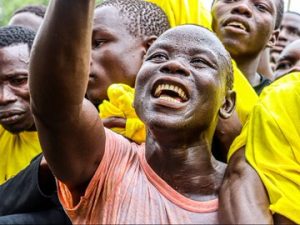
He, however, criticised some local leaders for failing to maintain existing murram roads despite the government providing road equipment.
“Even if the road is not tarmacked, it should be maintained in good condition and passable. We have stations in Arua and Moyo with graders, rollers, bulldozers, and tippers. You wonder why roads remain impassable. If somebody is sleeping, I’m going to wake them up,” he warned.
Health and Education Commitments
Turning to social services, President Museveni pledged to upgrade Obongi Health Centre IV to a General Hospital and elevate Indilinga HCII (in Aliba) and Lomunga HCII (in Gimara) to HCIIIs, to ensure that all six sub-counties in the district have functional health facilities.
“We are going to solve that by building health centre IIIs and a district hospital,” he said, noting that improved health and immunisation have contributed to population growth from 20,000 in 1980 to over 142,000 today.
On education, the President reiterated his opposition to school fees in government schools, promising to recruit 50,000 new primary teachers to fill staffing gaps.
“Some school committees claim they lack teachers and charge parents to pay extra staff, but I’m going to close that gap,” he stated.
Obongi currently has 24 government primary schools, 62 private primary schools, two government secondary schools, and 21 private secondary schools. Two new seed schools under construction will reduce the number of sub-counties without a government secondary school from four to two.
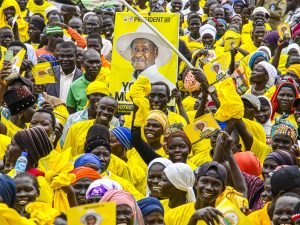
Wealth Creation and Parish Development Model
On the economy, President Museveni urged residents to distinguish between public infrastructure and personal wealth, stressing that individuals must engage in enterprise to improve household incomes.
“You don’t sleep on a tarmac road at night. In Kampala, there are roads, electricity, and internet, yet people still live in ghettos. So please don’t be diverted by development and forget wealth creation,” he said.
He outlined the evolution of the NRM’s household income programmes — from Entandikwa and NAADS to Operation Wealth Creation, Emyooga, and now the Parish Development Model (PDM) — which he called “the most comprehensive of all.”
According to figures presented at the rally, Obongi’s 28 parishes have received Shs 8.6 billion under the PDM, with Shs 8.36 billion (99.4%) already disbursed to 8,891 households.
“We shall maintain the annual allocation of Shs 100 million per parish and add Shs 15 million for leaders who have not been borrowing. We shall also provide funds for religious and cultural leaders, and for university graduates who fail to get jobs within two years,” he announced.
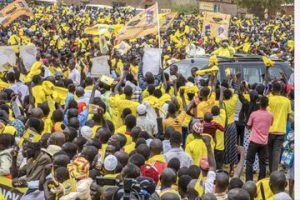
The President also said the government would introduce fish farming projects in Obongi to promote household incomes, noting that some fish farmers in Limoto already earn up to Shs 100 million annually.
Political Support and Local Appeals
Hon. Denis Hamson Obua, NRM Vice Chairperson for Northern Uganda, praised President Museveni for elevating Obongi to district status in 2019.
“In just six years, Your Excellency, the government has injected over Shs 209 billion into Obongi. In the last financial year alone, the district received Shs 17 billion,” Obua said.
Obongi LC5 Chairperson, Mr Abibu Buga Khemis Awadi, pledged overwhelming support for President Museveni in the 2026 elections. “In 2021, you got 65 percent of the vote in Obongi. In 2026, we are promising 90 percent,” Awadi declared.
Residents also petitioned the President to construct a bridge linking Obongi and Adjumani to ease transport and trade across the Nile.
Obongi, officially established in 2019, now comprises six sub-counties and town councils, 28 parishes, and 151 villages. The district’s voter register has grown by 34 percent since 2021, reflecting both population growth and improved access.
